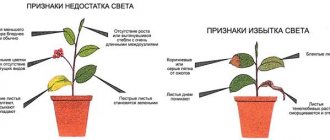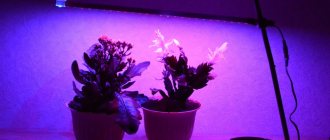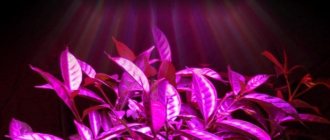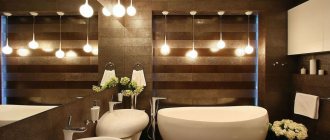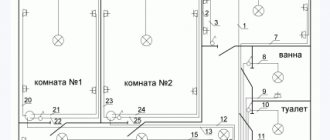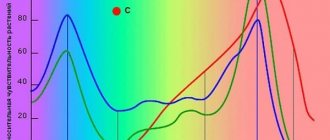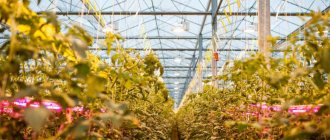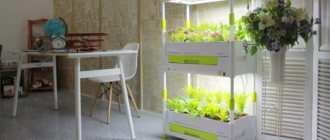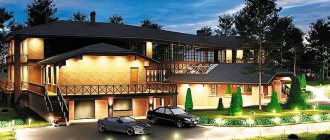Every experienced gardener knows the huge role that properly selected lighting for indoor plants plays. Along with watering and soil, light is an indispensable component on which successful growth directly depends. It is no secret that in the natural environment, some plants thrive in shaded areas, while others cannot develop without direct exposure to sunlight. At home, the situation looks similar. Let's talk in detail about how to properly make artificial lighting for indoor plants.
Decorative lighting and lighting for plant growth
A lamp for growing indoor plants is a great way to extend daylight hours. After all, many indoor flowers are of tropical origin, which means they experience a daily lack of solar energy, especially in winter. For effective plant growth, the daylight hours should be about 15 hours. Otherwise, they weaken, stop blooming and are susceptible to various diseases.
When planning the future illumination of indoor flowers, it is important not to miss the aesthetic component. The phytolight should become part of the interior, a unique decorative element. There are a huge number of lamps on sale with wall mounts of different shapes, suitable for any energy-saving lamp: CFL or LED. Depending on the size of the home flower garden, lighting can be made from several spot lights aimed directly at each green pet, or from tubular fluorescent lamps with a reflector. Using your own imagination, you can make an original LED phytolight yourself.
The most important component of growth is the light spectrum
In order to understand how inhomogeneous light is from different electrical sources and the sun, you need to look at their spectral composition. The spectral characteristic is the dependence of the radiation intensity on the wavelength. The solar radiation curve is continuous throughout the visible range with a decrease in the UV and IR regions. The spectrum of artificial light sources in most cases is represented by individual pulses of different amplitudes, which as a result gives the light a certain hue.
During the experiments, it was found that for successful development, plants do not use the full spectrum, but only its individual parts. The following wavelengths are considered the most vital:
- 640–660 nm – velvety red color, necessary for all adult plants for reproductive development, as well as for strengthening the root system;
- 595–610 nm – orange for flowering and fruit ripening;
- 440–445 nm – violet color for vegetative development;
- 380–400 nm – near UV range to regulate the rate of growth and formation of proteins;
- 280–315 nm – mid-UV range to increase frost resistance.
Lighting with only the listed rays is not suitable for all plants. Each representative of the flora is unique in its “wave” preferences. This means that it is impossible to fully replace the sun's energy using lamps. But artificial lighting of plants in the morning and evening hours can significantly improve their life.
Signs of lack of light
There are a number of signs by which it is easy to identify a lack of light. You just need to take a close look at your flower and compare it with the standard. For example, find a similar view on the Internet. A clear lack of illumination manifests itself as follows. The plant slows down its growth. The new leaves are smaller and the stem becomes thinner. The lower leaves turn yellow. The flower either stops blooming completely, or the number of buds formed is less than the statistical average. It is assumed that watering, humidity and air temperature are normal.
How much light do you need?
It is impossible to give a definite answer to this question. Just as a person can live in different parts of the globe, so an indoor flower can grow on a windowsill facing north, south, west or east. Throughout its life, the plant will strive to adapt to current conditions: stretch upward due to lack of light or, conversely, expose the next blossoming bud to the sun’s rays.
By observing the appearance of the stems and leaves, the size and number of flowers, you can determine the adequacy of the lighting level. At the same time, do not forget about what stage of development the indoor flower is at: growing season, flowering, seed ripening. At each stage, it takes light from the sun of the wavelength that it needs at the moment. Therefore, when organizing additional lighting, it is important to take into account the qualitative component of the light flux.
Long-term exposure to bright light from the sun and lamps with an illumination level of more than 15 thousand lux is favored by those indoor flowers that grow in the open air in their natural habitat. These are many people's favorite crassula, geranium, kalanchoe, and begonia. Artificial lighting for plants of this type in the evening will benefit them.
Representatives of the flora that feel comfortable in illumination of 10–15 thousand lux include spathiphyllum, clivia, saintpaulia, tradescantia and dracaena. The leaves of these types of indoor flowers do not like hot sunlight, but also do not tolerate early twilight. Therefore, the ideal place for them would be a window sill with access to the west, where in the evening their leaves will receive the necessary energy from the setting sun.
So-called shade-loving plants can bloom and develop away from the window opening, being content with illumination of up to 10 thousand lux. However, this does not mean that they will die if they are placed in a brighter place. They just need less direct sunlight. These include some types of ficus and dracaena, philodendron, as well as tropical vines.
How to choose a phytolamp by shape
Most often, phytolamps come in two shapes – linear and round. The first type of source can be either LED or fluorescent. The second is LED (light bulbs with E27 socket). These lamps are convenient because, having bought one phytolamp with a classic base, you can screw it into a regular table lamp.
The advantage of linear models is the uniform distribution of light flux. The disadvantages include the relatively large sizes.
Before you buy a phytolamp, decide how you will place the plants under it.
If they will stand in the shape of a rectangle, for example, on a windowsill, choose a linear shape. If it is in the shape of a circle or square, a round one is better.
A small round lamp is more convenient to use for small plants in pots or a small number of seedlings. If there are a lot of seedlings, you will have to use several round lamps. Or give preference to a linear device.
There are also:
- transformable lamps (“petals” can be moved apart to increase the lighting area, or directed to one point to create an area with the maximum amount of light);
- bayonet phytolights (inserted directly into a pot with a plant, but limited in height adjustment);
- table phytolights (elongated, but in the form of a table lamp);
- LED phytolamp (attached to the surface using an adhesive base, much longer than a conventional linear phytolamp, you can wrap a significant part of the rack with seedlings);
- spotlights (convenient for greenhouses);
- ready-made mini-gardens (structures with lighting at the top and pots at the bottom).
Supplementary lighting for plants and artificial lighting sources
In most cases, indoor plants need additional lighting. Flowers, which at first glance have bright green succulent leaves and bloom regularly, will look even better if they are exposed to a phytolamp. If someone thinks otherwise, then he has an excellent chance to be convinced of the error of his thinking and assemble a phyto-lamp with his own hands. To extend daylight hours, various sources of artificial light are used. Let's look at each of them and figure out which light is best for plants.
Incandescent lamps
Illuminating plants with incandescent lamps is the least effective for several reasons. The emission spectrum of conventional light bulbs with a spiral is strongly red-shifted, which does not contribute to photosynthesis in any way. Low efficiency and, as a consequence, enormous heat generation drive their energy and light efficiency to zero. In addition, incandescent lamps have the shortest service life compared to other artificial light sources.
Fluorescent lamps
Tubular fluorescent or, as they are most often called, energy-saving fluorescent lamps of the T8 full spectrum type (T = 5300–6500°K) are considered the best option for illuminating indoor plants for many years.
They have earned many positive reviews due to the presence of a selective spectrum, efficiency and low heat transfer combined with reasonable cost. Companies specializing in the production of fluorescent lamps offer plant growers an improved option - a phytolamp with a selective emission spectrum. They work predominantly in the blue and red range, as can be seen from the characteristic glow. But the cost of such lamps for illuminating plants is an order of magnitude higher than their conventional counterparts.
DNAT
A sodium lamp is the most efficient light source. In terms of luminous efficiency and working life, these lamps are comparable to LEDs for plants. But they are not suitable for home use due to their excessively high brightness (more than 15 thousand lux). But in many greenhouses and conservatories, growing plants under artificial lighting is based precisely on gas-discharge lamps. Due to the fact that they emit more red light, they are installed in combination with 6500K fluorescent lamps.
LED light sources
All LED phytolights are divided into three groups:
- bicolor;
- with multispectrum;
- with full spectrum.
Bicolor or two-color lamps are based on blue (440–450 nm) and red (640–660 nm) LEDs. Their light is considered to be the most optimal for organizing illumination of any plants during the growing season. This working spectrum favors the process of photosynthesis, which leads to accelerated growth of green mass. That is why summer residents prefer blue-red LED lamps when growing vegetable seedlings on the windowsill.
LED lamps with a multispectrum have a wider application due to the expansion of the red range into the region of infrared and yellow light. They are in demand for illuminating adult plants, stimulating flowering and fruit ripening. In apartment conditions, it is better to use LED multispectrum for flowers with a dense crown.
A phytolight with a full spectrum of radiation can be used to illuminate flowers in an apartment, regardless of the type and location. This is a kind of universal artificial light source that emits over a wide range with maximums in the red and blue zones. The full spectrum LED lamp is a tandem of energy efficiency and light energy reminiscent of the action of sunlight.
Today, the creation of favorable conditions for a widespread transition to phyto-LEDs is not happening for two reasons:
- high cost of high-quality lamps for plants;
- a large number of fakes based on conventional LEDs.
Types of lamps
To provide normal additional lighting or to completely illuminate a houseplant in an apartment, several types of light bulbs are used. These are traditional incandescent lamps, halogen, LED lamps, lamps, LED strip. Let's consider their characteristics and features.
Incandescent lamp
This is the most common type, which everyone is familiar with - there are or were such lamps in every apartment. Due to electrical energy, the tungsten spiral, which is located in a glass container, is heated. The device is screwed into the socket, and no special equipment is required for connection.
The disadvantage is the fact that there is no blue color in the spectrum. The light output is very low and amounts to 17-25 Lm/W. This is not the best choice for indoor plant lighting. The lamp gets very hot and if placed above flowers even at a height of 1 m, it can cause burns. If you raise the lamp more than 1 meter, the lighting efficiency will tend to zero.
Luminescent
A fluorescent lamp is a bulb with electrodes on each side. They are connected by a tungsten helix. Inside the tube there are inert gases or mercury vapor. A special layer of phosphor is applied to the inner surface of the flask.
This is what a fluorescent lamp looks like
There are three types of such lamps:
- general purpose products;
- special purpose;
- compact models.
The general-purpose model has good characteristics - high light output, low heat emission, and long service life. In plant growing, they are used to organize additional illumination of indoor plants when the daylight hours are short. But the main thing about these lamps is their very limited spectrum. It is not recommended to use paws for constant lighting.
Special-purpose fluorescent lamps are distinguished by the presence of a phosphor layer. Due to this improvement, the spectrum of the lamp is very similar to that needed for plants. This lamp can be selected in cases where it is necessary to provide full illumination and periodic additional illumination. Also, these lamps are often chosen for creating decorative lighting with your own hands.
The disadvantages include the inflated cost and an electronic ballast installation, without which it will not be possible to connect the device to the network. The lamp can provide the right light, but it is recommended to use it only when there are no other devices with a power of 200-300 W.
Gas discharge
These products are capable of generating the brightest light. There are several types of these lamps; mercury, sodium, and metal halide can be distinguished. Mercury models are among the very first. There is no special coating on the inside of the bulb, and the light output coefficient is very low. They emit light with a bluish tint that is unpleasant both for the human eye and for green friends.
Updated models with improved spectral characteristics are now being produced. They have become one of the lighting options for greenhouses and greenhouses. But the problem with heat transfer has not yet been solved.
Sodium models have greater brightness; these are effective models with high light output and long service life. The spectrum is in the red zone. With two lamps you can illuminate a huge area in the winter garden or a large collection of plants. To ensure balance in the spectrum, it is recommended to alternate mercury and halogen models. Green plants will be happy.
Article on the topic: Comparison and selection of a gas boiler for heating a house: one or two circuit, floor-mounted, wall-mounted
Metal halide light bulbs are the most advanced devices for lighting home plants, as well as greenhouses and greenhouses. They differ in the following characteristics:
- high power;
- high service life;
- optimal spectral balance.
To use such light bulbs in your home, you will need to purchase a special socket. There is also one big drawback of such lamps - the cost. It is significantly higher than the price of basic analogues.
What light is best for growth?
Of course, the ideal light source is solar energy. In apartments with windows facing southeast and southwest, you can grow any flowers, placing them in different parts of the room. But don’t be upset for those who only have a north-facing view from their window. Fluorescent and LED lamps for lighting plants compensate for the lack of sun rays.
Fluorescent lamps for plants are a time-tested budget option. They are suitable for those who are trying to create normal conditions for a flower with little investment. LED phytolamps are for those who want to speed things up and achieve the best results in a short time, despite the price of several thousand rubles.
Consider the radiator area
The radiator is an aluminum housing, which in base lamps is located in a circle or, if it is a linear lamp, the entire housing is the radiator. In Figure 3, the radiator is indicated by arrows.
Figure 3
The heatsink is designed to disperse the heat produced by the diodes. Therefore, the volume of the radiator must be designed for the number of diodes so that they do not overheat. The maximum temperature on the diode crystal should not exceed 70-75°C, otherwise they will “degrade”. That is, if there are many diodes in a lamp and the radiator is small, such a lamp will quickly fail.
Figure 4
In order for the LED phytolamp to work properly, the ratio between the radiator area and the number of diodes must be well adjusted. The distance between the diodes is equally important, that is, if there is enough space between the diodes, the heat is distributed faster. An example of the correct “fitting” of diodes on a radiator is shown in Figure 4.
You can find out detailed information about LED phytolamps from the following video:
